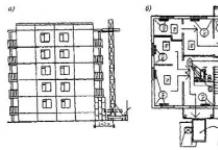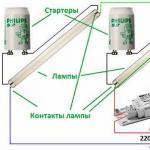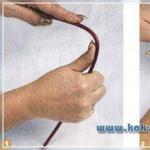It is a well-known fact that lamps with fluorescent lamps are widespread not only in factories and organizations, but also in private houses and apartments. Surely every second person has an old, dusty similar lighting device in their garage or closet that no longer works, and it would be a pity to throw it away. Then why not repair these lamps yourself? Moreover, if it is possible to find old and unnecessary lamps somewhere, repairs will not cost a penny, and now we’ll figure out how to repair them.
The main thing you need to know before you start repairing fluorescent lamps is the principle of their operation.
How the device works
You can understand the principle of operation of a fluorescent lamp using the example of the schematic image presented below.
On it you can see:
- ballast (stabilizer);
- a lamp tube including electrodes, gas and phosphor;
- phosphor layer;
- starter contacts;
- starter electrodes;
- starter housing cylinder;
- bimetal plate;
- filling the flask with inert gas;
- filaments;
- ultraviolet radiation;
- breakdown.
A layer of phosphor is applied to the inner wall of the lamp in order to convert ultraviolet light, which is invisible to humans, into illumination received by normal vision. By changing the composition of this layer, you can change the shade of the color of the lighting fixture.
So, knowing the structure of the lamp and the circuit diagram of the lamp, you can begin to restore it.
Fluorescent lamp malfunctions and ways to eliminate them
The first step is to check if there is a fault in the fluorescent lamp using a tester or multimeter. It must be remembered that in the circuit, for example, of an Armstrong lamp with electronic ballasts for 4 lamps (4 x 18), if one burns out, all four will not work. In devices with one starter for 2 tubes, both tubes must be working, but when connected with one working one, the lamp will work even if the second one is faulty.
After applying power, if the lamp does not light, you need to check the voltage supply to it. This can be done from the input terminal block.
Malfunctions of lamps with a choke
So, if the previous steps have been completed, and the lamp still does not work, you need to start checking all components of the lighting device circuit, i.e., directly begin repairing fluorescent lamps.

A visual inspection can tell a lot; sometimes punctures, dents and other reasons why the lamp does not light up are visible to the naked eye.
As with any repair, you need to check the basics first. It makes sense to replace the starter with one that is known to be working, after which the lamp should light up, and then this malfunction of the fluorescent lamp can be eliminated. However, a starter with suitable parameters may not always be at hand, but it is somehow necessary to check the one that is available, what if the reason is not in it?
Everything is quite simple. You will need a regular lamp with an incandescent bulb. Power must be supplied to it like this: connect the starter being tested in series into the gap in one of the wires, but leave the second intact. If the lamp lights up or blinks, then the device is operational and the problem is not with it.
If even after this the lamp does not light up, then you will have to ring all the lamp wires for continuity, and also check the voltage at the contacts of the sockets.
Malfunctions of lamps with electronic ballasts
Here, repairing a fluorescent lamp comes down to only checking the lamps, the integrity of the wiring and holder holders. If they are in order, you will simply have to replace the electronic ballast.
Of course, if a person knows how to check electronic ballast elements for serviceability, and also has even a little knowledge of radio electronics, then repairing electronic ballast will not be difficult.
Repair of electronic ballast of fluorescent lamps

Most often, if the electronic ballast (ballast) fails, then the burnout of the transistor is to blame, which can sometimes be seen with the naked eye. If it is impossible to determine this visually, you will have to remove the transistors from the circuit and test it with a multimeter.
If they are working properly, then their resistance will be 400–700 Ohms. If one of the transistors burns out, the 30 Ohm resistor may also burn out automatically.
There is also another weak point in the circuit - a low-impedance fuse of 2-5 ohms. Very rarely, the cause may be burnt elements of the diode bridge. These are all possible reasons; after they are eliminated, the ballast repair will be completed, that is, the restoration of the burnt electronic ballast.
Possibility of starting with burnt-out equipment
Repairing fluorescent lamps also has its own little tricks. For example, there was an urgent need to start such a lighting device, but the starter was faulty, and there was no way to replace it. This circuit element itself serves to heat the filaments in the fluorescent tube.
Well, what if, for example, the throttle fails? Nowadays you can’t find it in all stores.
Throttleless activation
It is quite possible to prolong the operation of a burnt-out light fixture. There is a way in which you can turn on a fluorescent fluorescent lamp without a throttle and starter (connection diagram in the figure). Of course, this method is not suitable for everyone; you need to have at least a little understanding of electrical engineering.

Voltage is supplied after a short circuit of the filaments. The rectified voltage doubles, which is quite enough to start the lamp (in theory, this function is performed by the inductor). Capacitors C1 and C2 (in the diagram) must be selected for 600 V, and C3 and C4 - with a rated voltage of 1,000 V. After some time, mercury vapor, of course, will settle in the area of one of the electrodes, and the light from the lamp will become much less bright. It will be possible to get rid of this simply by changing the polarity, i.e. simply by deploying the reanimated burnt-out LL.
Starterless inclusion
There are lighting devices that are designed exclusively for operation without a starter. Such lamps are marked RS. If such a tube is installed in a lamp equipped with a breaker, the lamp burns out very quickly. This happens due to the need for more time to warm up the spirals of such fluorescent tubes. The starter's durability is short, it often burns out, and therefore it makes sense to consider the possibility of how to turn on a fluorescent lamp without it. To do this, you will need to install secondary transformer windings. If you remember this information, then the question will no longer arise of how to light a fluorescent lamp if the starter burns out (connection diagram below).
Thus, without extra costs, you can even assemble a fluorescent lamp with your own hands.

Summarizing
Therefore, the conclusion suggests itself - there is no point in throwing away something that is completely repairable and viable. You just need to think carefully with your head, and then work with your hands, and the lighted lamp will not only add confidence in your abilities, but will also have a good effect on your financial condition. And nowadays, the money saved on a lamp can be invested in more necessary things.
Do you know why LED lights stay on when the switch is off? Agree: problems in the functioning of the lighting system will not please anyone. Do you prefer to find the cause of the LEDs on your own without involving an electrician? However, you don’t know where the weak point is?
We will show you how to deal with a difficult problem. The article describes the most common situations that cause lamps to glow after they are turned off. Ways to solve the problem are considered, recommendations are given for choosing a reliable light source from a trusted manufacturer.
The measures we recommend will allow you to avoid a number of difficult situations during the further operation of such devices. The special design of LED lamps guarantees economical electricity consumption and a long service life.
In order to find out the reason for the device to glow after turning it off, you need to carefully examine the design of the LED device, and also find out the principle of its operation.
The design of such a lamp is quite complex; it consists of the following elements:
- Chips (diodes). The main element of a lamp that produces a stream of light.
- Printed aluminum board on a heat-conducting mass. This component is designed to remove excess heat to the radiator, thereby maintaining the temperature in the device that is necessary for the correct operation of the chips.
- Radiator. A device to which heat energy removed from other components of the LED lamp is supplied. Typically this part is made of anodized aluminum alloy.
- Base. A lamp base designed to connect to a lamp socket. As a rule, this element is made of brass, coated with a layer of nickel on top. The applied metal resists corrosion while promoting contact between the device and the socket.
- Base. The lower part adjacent to the base is made of polymer. Thanks to this, the housing is protected from electric shock.
- Driver. A unit that ensures stable, uninterrupted operation of the device even in the event of a sharp change in voltage drops in the electrical system. The operation of this unit is similar to a galvanically isolated modulator of an electric current stabilizer.
- Diffuser. A glass hemisphere covering the top of the device. As the name suggests, the part is designed to maximize the dispersion of the light flux emitted by the diodes.
All components of the device are connected to each other, which ensures its reliable operation.
Operating principle of the equipment
Specific circuits of LED devices produced by different manufacturers may differ significantly from each other. However, they are all based on a general operating principle, which can be schematically depicted as follows.
Scheme of operation of an LED lamp. To create a greater p-n junction effect, semiconductors are used in structures, the surface of which is doped with various materials

A light switch with a backlight function does not allow the circuit to be completely broken, so the lamps will glow dimly for a long time. When this option is disabled, the system will warm up and the LED will go out.
In this case, the devices come into conflict: even a switched off switch cannot completely open the electrical circuit due to the backlight, which is powered through a resistance. Since the system remains open, a small voltage reaches the lamp, which causes a dim glow.
Similar problems can be caused when using other electrical devices: photocells, timers connected to lamps and lights.
How to solve this problem. Since such a defect with LED lamps that light up even when the switch is off is quite common, electrical specialists have accumulated a lot of experience in correcting the situation.
These may be the following options:
- switch replacement;
- turning off the backlight;
- installation of an additional resistor;
- replacing one of the lamps in the chandelier with a weaker analogue;
- use of resistance with a high power rating.
The simplest way is to replace an illuminated switch with one without an additional function. However, such a solution is associated with additional monetary costs, as well as with reinstallation of the device.

The continued burning of the lamp after the switch is turned off may also be due to the use of a high-capacity capacitor in the device, where a charge remains sufficient for a weak glow
If the presence of backlighting on the switch is not important, you can simply use wire cutters to cut through the resistance that sets the power supply for it. Adding a shunt resistor will help turn off the LED while maintaining the backlight. A device with a resistance exceeding 50 kOhm and a power of 2-4 W can be purchased at a specialized store.
To connect it, you need to remove the lampshade from the lamp, and then attach the wires coming from the device to the terminal block with network conductors, which will allow you to connect parallel to the lamp.
In this case, the current passing through the LED will not flow through the driver capacitor, but through the newly connected node. As a result, reactance recharging will stop and the LEDs will go out when the switch is turned off.

To correct the operation of a multi-arm chandelier, it is enough to install one additional resistor. There is no need to connect such a part to each of the lamps
If a problem is identified in a multi-arm chandelier, you can install an incandescent lamp with a minimum power in one of the sections, which will collect all the current coming from the capacitor.
A similar solution can be applied to a single-arm chandelier by installing an adapter from one to two sockets. At the same time, when using this method, the weak glow of one bulb will still remain.
The desired result will also be achieved by replacing the usual resistance in the switch with its analogue with a large number of Ohms. However, to perform such a manipulation, you will need to consult an electrician.
Reason #2 - faulty electrical wiring
Quite often, the source of lamps that do not turn off is faulty wiring. If an insulation failure is suspected, high voltage should be applied to the device for several minutes to simulate the conditions that cause breakdowns in the electrical network.
To find the location of damage to a hidden cable, you can also use homemade or professional products designed for this purpose.
If the problem really lies in worn-out insulation, the electrical wiring in the apartment must be partially or completely replaced. With open cable routing, the process will take a minimum of time and effort. More difficult work awaits if hidden wiring was installed in the housing, walled up in the walls.

Poor insulation can cause problems with LED lighting. This factor often occurs when electrical wiring has been in use for a long time.
In this case, decorative finishing, such as wallpaper, as well as plaster, will have to be removed from vertical surfaces. After opening the groove where the wires are located, the entire cable or damaged section is replaced. Finally, it is necessary to seal the channels with plaster, and then plaster and refinish the walls.
An alternative temporary solution may be to connect a device to the network, for example, a resistor or relay, which provides additional load. Similar devices, the resistance of which is weaker than that of LEDs, are connected in parallel to luminous lamps.
In this case, the current is redirected, which is why the operation of LED devices is regulated: the light goes out immediately after the switch is turned off. The newly connected element will also not function due to low resistance.
Reason #3 - incorrect connection of the lamp
The reason for the continuous burning of the lamp may be hidden in connection errors. If, when installing the switch, a zero was connected instead of a phase, it will turn off when the circuit is opened.
At the same time, due to the retained phase, the wiring will still be energized, which is why the device will glow when the switch is turned off.
Russian products from the brand and Era have proven themselves well. LED lamps are produced in a large assortment. When choosing them, you should pay attention to both appearance and technical characteristics and operating conditions
So, when an electric current is applied, thermal energy can accumulate in the device, which is why the LED will remain on even after it is turned off, albeit for a short time. Companies combat this phenomenon by using resistors in the manufacture of equipment made from materials that prevent the accumulation of excess heat energy.
One of the important factors for the smooth operation of LED lamps is the choice of products of appropriate quality. In this case, one should take into account the features under which the devices will have to function, as well as their compatibility with other equipment connected to the power grid.
Before purchasing, it is recommended to carefully read the instructions supplied with the LED devices, which indicate the operating rules. It should be noted that a number of popular devices, such as timers, photovoltaic modules, can cause problems with the operation of LEDs.
It is also important to carefully examine the appearance of the light bulb, paying attention to the joint between the body and the base, which should be securely adjacent to the main part without any defects. If there are scratches, dents or sloppy seams, the likelihood of problems with the glow increases significantly.

There are also advanced LED lamp technologies, such as those using LED filaments. Although their cost is slightly higher, it is compensated by their long service life and excellent quality.
An element such as a radiator is important. It is best to choose an LED in which it is made of aluminum, but ceramic and graphite analogues also have high performance. The size of this part, which is responsible for the removal of thermal energy, the release of which can also occur when the light is turned off, is also important.
For a high-power LED to operate correctly, it is necessary to use a large radiator, while for a weak device a compact one will be sufficient.
As a rule, in specialized stores, sellers test turn on the lamp. In this case, you need to try to check the flicker level: the lighting device should emit an even luminous flux without any pulsation.
Since it is quite difficult to assess this factor with the naked eye, it is better to film the device turned on with a mobile phone video camera. The recording will allow you to better evaluate his work.
Conclusions and useful video on the topic
The video reveals the two most common reasons why LED lamps burn even after turning off the power. Detailed instructions for eliminating them are also provided:
The glow of the lamps when the switch is turned off is not only unpleasant for the eyes, but also sharply reduces the life of the LEDs. To eliminate the problem, you need to establish the cause that causes a malfunction in the functioning of the devices, and then eliminate it.
In most cases, correcting the situation will require a minimum of time and effort. You can do the necessary work yourself using basic tools.
Please leave comments in the block below. Share useful information that may be useful to site visitors. Ask questions, tell us about your personal experience in eliminating LEDs from collapsing after switching off, post photos related to the topic of the article.
burning lamp
Of course, there are two sides to this problem. Let's look at the second one. We often hear about “saleswomen”. But they don't exist. There are girls who work in stores. This is their profession. However, why on earth should the name of a profession be turned into a definition of a person? Let's be fair. After all, we don't call the girls who live on Fifth Avenue "brides."
Lou and Nancy were friends. They came to New York to look for work because their parents could not feed them. Nancy was nineteen years old, Lou was twenty. These were pretty, hardworking girls from the provinces who did not dream of a stage career.
The guardian angel led them to a cheap and decent boarding house. Both found a place and began independent lives. They remained friends. Allow me now, after six months, to introduce you: Annoying Reader - my good friends Miss Nancy and Miss Lu. As you bow, pay attention - just subtly - how they are dressed. But only unnoticed! They don't like to be stared at, any more than a lady in a box at a race.
Lou works as a piecework ironer in a hand laundry. Her purple dress doesn't fit her well, her hat feather is four inches too long, but her ermine muff and boa cost twenty-five dollars, and by the end of the season the ermine brethren will be in shop windows labeled "$7.98." She has pink cheeks and sparkling blue eyes. By all appearances, she is quite happy with her life.
You will call Nancy a saleswoman - out of habit. This type does not exist. But since the jaded generation is looking for type everywhere, she can be called a “typical saleswoman.” She has a high pompadour hairstyle and the most correct English blouse. Her skirt is impeccably cut, although it is made of cheap material. Nancy does not wrap herself in furs against the sharp spring wind, but she wears her short cloth jacket with such chic, as if it were an astrakhan coat. Her face, her eyes, oh ruthless type hunter, contain an expression typical of a saleswoman: silent, contemptuous indignation of trampled femininity, a bitter promise of future revenge. This expression does not disappear even when she laughs cheerfully. The same expression can be seen in the eyes of Russian peasants, and those of us who live will see it on the face of the Archangel Gabriel when he blows the last trumpet. This expression should confuse and destroy the man, but he often grins and presents a bouquet with a string behind it.
Now raise your hat and leave with a cheerful “see you soon!” Lou and Nancy’s mocking, gentle smile, a smile that for some reason you can’t catch, and she, like a white moth, fluttering, rises above the rooftops to the stars.
The girls were waiting at Dan's corner. Dan was a loyal fan of Lou's. Devoted? He would have been with her even when Mary had to look for her sheep (1) with the help of hired detectives.
Aren't you cold, Nancy? - Lou noted. - What a fool you are! Hanging out in this little shop for eight dollars a week! Last week I made eighteen fifty. Of course, ironing is not as chic as selling lace behind a counter, but the pay is good. None of our ironers earn less than ten dollars. And this work is no more humiliating than yours.
Well, take it for yourself,” said Nancy, turning up her nose, “and my eight dollars and one room will be enough for me.” I love to have beautiful things and great people around me. And then, what opportunities there are! In our glove department, one married a foundry worker or whatever his name is, a blacksmith, from Pittsburgh. He's a millionaire! And I can catch just as bad. I don’t want to brag about my appearance at all, but I don’t play small. Well, what options does a girl have in the laundry?
That's where I met Dan! - Lou declared victoriously. - He came in to get his Sunday shirt and collars, and I was ironing on the first board. Everyone here wants to work at the first board. That day Ella Majinnis fell ill and I took her place. He says that at first he noticed my hands - so white and round; Uh, my sleeves were rolled up. Very decent people come into laundries. You can immediately see them: they bring laundry in a suitcase and don’t hang out in the doorway.
How can you wear a blouse like that, Lou? - asked Nancy, casting a languidly mocking glance from under her heavy eyelids at her friend’s colorful dress. - Well, you have good taste!
And what? - Lou was indignant. - I paid sixteen dollars for this blouse; and it costs twenty-five. Some woman put it in the wash but never picked it up. The owner sold it to me. It's all hand embroidered! You better tell me what this gray disgrace is on you?
This gray disgrace,” Nancy said coldly, “is an exact copy of the disgrace that Mrs. Van Alstyne Fisher wears.” The girls say that last year her account in our store was twelve thousand dollars. I sewed my skirt myself. It cost me one and a half dollars. 3 and five steps you won’t be able to distinguish them.
Okay, really! - Lou said good-naturedly. - If you want to go hungry and put on airs, that’s your business. But my job is good for me, as long as it pays well; but after work I want to wear the most elegant thing that I can afford.
Then appeared Dan, a lineman (earning thirty dollars a week), a serious young man in a cheap tie, who had escaped the stamp of swagger that the city imposes on young people. He looked at Lou with the sad eyes of Romeo, and her embroidered blouse seemed to him like a cobweb, in which any fly would consider it lucky to become entangled.
My friend Mr. Owen - meet Miss Danfors, Lou introduced.
“I’m very glad, Miss Danfors,” said Dan, holding out his hand. - Lou talked a lot about you.
“Thank you,” Nancy said and touched his palm with the tips of her cold fingers. - She mentioned you - sometimes.
Lou giggled.
Did you pick up that handshake from Mrs. van Alstyne Fisher? - she asked.
Moreover, you can be sure that it is worth learning,” said Nancy.
Well, I don't need it. It's too much. Invented to show off diamond rings. When I have them, I'll try.
Learn first,” Nancy wisely noted, “then the rings will appear sooner.”
A chandelier is the main source of artificial light, so you can’t do without it. Have you started a large-scale renovation or just decided to refresh the interior by replacing the lamp? Here – molight.ru they will help you make the right choice.
How to properly connect a chandelier and what troubles can you expect during its operation? We will answer these questions in today's material. So let's get started.
Various chandelier connection options
Do you want to connect a new chandelier to a switch, but are not sure if you will do it correctly? We will help you deal with different situations.
Wires to be connected
There are only three options here:
PE – protective ground wire (yellow-green).
Modern chandeliers most often have markings. But they began to apply it quite recently, so you often come across specimens without letter designations. If they are missing, it is best to check the wires with an indicator screwdriver. This will allow you to accurately determine the cable type.
Grounding is not always found and does not perform any function other than protective; there will be no problems with it. This wire must be connected to a similar one in the ceiling; if there is no such wire in the device, it is simply insulated.
What do you need to arm yourself with before work?
Voltage indicator (special indicator screwdriver).
Pliers.
Multimeter.
Insulating tape.
Terminal block.
It would also be a good idea to stock up on a marker, a passport for the chandelier and a stable stepladder. The first will help you figure out the type of wires, and the second tool will help you avoid falling while working.
Connection options depend on the number of wires in the chandelier and ceiling. Each case will require a different approach.
Attention! Be sure to turn off the electricity at the distribution panel before starting work. Otherwise you may get an electric shock.
Case one: 2 wires and 2 (chandelier and ceiling)
This is the easiest way to connect. There's no need to think too much here. Find out in advance where the phase is and where the zero is, and connect the wires to each other. At the same time, remember that the phase is led to the chandelier and a single-key switch, while the zero goes directly to the junction box.

If it is difficult to immediately determine phase and zero, an indicator screwdriver will help you. Before this you will have to turn on the electricity. And as soon as you figure out the cables, turn it back off.
The wire to which the indicator reacts with a lighted light is a phase; if there is no reaction, it is zero. For convenience, you can make the designations with a marker. This especially helps when there are three or four wires or more.
Case two: 2 and 3
First of all, you need to determine which wire is which. One of the three cords on the ceiling will be neutral, two will be phase. This situation suggests that the electricians intended to connect the chandelier to a switch consisting of two keys. However, if the lamp has only two wires, a single-key wire will suffice.
We act according to logic. We connect a phase to the two phase wires on the ceiling, and a neutral cord to the neutral wire.
Case three: 3 and 2
In such a situation, the chandelier will be connected to a single-key switch. Twist the neutral wires in the ceiling light and connect them to the neutral cord in the ceiling. The same must be done with phase wires.
There is nothing complicated here and you don’t need to be afraid of the difference in the number of cords.

Case four: 3 and 3
This is the most interesting option, but if you gradually understand the sequence of actions, it turns out that everything is not so complicated.
Here you can distribute the load on the lamps and connect the chandelier to a two-key switch.
The standard wire markings used are: L1 (orange phase cable), L2 (yellow phase cable), N (blue neutral cable). However, not all manufacturers use such color and letter designations, so it is better to check the cables yourself.
All light bulb wires must be divided into two groups. Each of them is individually connected to only one wire, first to the one to which the phase is suitable, and then to zero.

This way you will ensure that when you press the first key of the switch, one group of lights will light up, and when you press the second, another. Most often, this method is used for chandeliers with five shades. Use one key to turn on two lamps, and the second – three.
Case five: 3 and 4
In this case, the fourth wire on the ceiling is protection, grounding. This option is most often found in new buildings or private houses. Dealing with him will not be difficult. If the light fixture has a green/yellow ground cable, simply connect the wires. If the chandelier does not have such a cable, insulate the protective cord from the ceiling. Otherwise, the connection of phase and zero is identical to the previous diagram.
Why doesn't the chandelier light up?
We don’t connect a new chandelier very often, but we use it all the time. Problems in its operation are common and require an urgent solution, since it is difficult to cope without a ceiling lamp.
So, how do you understand why the chandelier is not working?
Let's start by checking the light bulbs. In conventional incandescent lamps, their serviceability is checked by the integrity of the tungsten filament. It's torn, which means it's burned out. But sometimes, even with a whole spiral, the light bulb is faulty. Then you need to pick up a multimeter. Place one feeler gauge on the base thread. If the arrow moves, the light bulb is intact; if not, the light bulb is damaged. In the first case, you will have to begin a more thorough repair of the lighting fixture, in the second, replace the light bulb. By the way, lamps in LED chandeliers can only be checked with a multimeter.
The next stage of troubleshooting is the switches. It happens that the contacts simply burn out, and as a result, the current does not reach the cartridges. You need to unscrew the switch. If you notice anything wrong, strip the wires to a metallic color.
If everything is in order with the contacts, we go further and carefully inspect the wiring on the ceiling. The current may not reach the chandelier itself. Remove the lamp and use an indicator screwdriver to see if there is voltage in the wires. A break could occur. If you find that the cables are not in order, you have two options: replace the old wiring or extend the damaged wire to connect to the chandelier. The first one is better, because this way you will protect yourself from such troubles in the future.
When everything is in order with the wiring, then only the chandelier remains. A simple lamp needs to be disassembled and the condition of the wire connections and insulation checked. One of the cables probably burned out due to a short circuit. Be careful and you will definitely find the problem.
As a result of such a scrupulous analysis, the chandelier will begin to work, have no doubt.
Connecting and repairing a lamp is not that difficult, the main thing is to slowly figure out what’s what, and then everything will go like clockwork.
Featured articles

About cases when a lamp in the same lamp constantly burns out. About high starting currents in incandescent lamps, about transient processes and briefly about ways to solve the problem.
The flick of a switch: the light bulb in the toilet flashes, momentarily illuminating the modest interior of the restroom, and that’s it. It shone brightly, but not for long. Having dealt with our natural needs in the twilight, we drag in a stool and unscrew the damaged lamp. Of course, there is no way to help her.
We screw in a new lamp and put the incident out of our heads. And the next day, suddenly everything repeats: a click, a flash and the sudden death of the lamp. What kind of trouble is this! Maybe the lamps are unsuccessful, defective? No way - exactly the same one is burning in the corridor and without any incidents.
Remembering in vain both Ilyich and Edison, we stock up on light bulbs and reluctantly spend our entire supply on one single lamp - all in the same toilet. And the lamps keep burning out and burning out. And precisely at the moment of switching on, that is, switching. Well, why, in the end?
In fact, any electrical equipment suffers during switching, not just . It's just that the latter are the least fortunate. The electrical resistance of their filament is very dependent on temperature, and during operation they warm up to more than two thousand degrees Celsius. In this case, the nominal operating mode of the lamp corresponds to a heated filament, which has a high resistance. When a cold coil is turned on, the electric current can be ten times higher than the rated current due to the reduced resistance. Figuratively speaking, after switching on, the lamp receives a real electric shock of increased power.
Such impacts in themselves are unpleasant and do not contribute to the long service life of the lamp and its filament. But the situation can be aggravated by another factor, due to which it turns out that it is in a particular lamp that the lamps burn out with enviable consistency. This factor is transient processes during switching.
After all, current begins flowing through the light bulb immediately after voltage is applied. And if the lamp, for example, has a power of 60 watts, then, considering the load to be purely active, we conclude that the electric current should be approximately 0.27 amperes. This is in nominal mode. When you turn on the cold thread, all 2.7 amperes are obtained. But how will the current change from zero to 2.7 amperes? Jumpily, immediately after turning on the switch, or smoothly, after some time?
So, according to the theory of transient processes, the transition from complete absence of current to 2.7 amperes cannot be instantaneous. This, perhaps, is not surprising - after all, there are practically no instantaneous processes in life, there are only processes that occupy very short periods of time from our human point of view. So the process of changing the electric current in a light bulb in a restroom takes thousandths, maybe hundredths of a second.
Here, of course, our reasoning smacks of philosophy a little, but electric current also takes some time to accelerate to the speed of light. This is the first thing. And secondly, the duration of transient processes in any circuit is affected by the presence/absence of a reactive load. So, according to one of the laws of commutation, physically cannot change instantly. The field created by the inductance will prevent the current from changing. And the greater the inductance, the slower the current will reach its steady, final value.
According to the second law of commutation, the voltage across a capacitive element, that is, a capacitor, cannot sharply drop or increase. The capacitor takes time to release or accumulate its charge. And the greater its electrical capacity, the more time it will take to make changes.
These laws apply in both AC and DC circuits. But someone will say: “What other inductors and capacitors? We were talking about an ordinary light bulb - what does it have to do with it?” And indeed, one could agree: after all, the reactance of the filament of a lamp is only a fraction of a percent of its active resistance. That is why the reactance of an incandescent lamp is neglected in calculations.
But just because it's neglected doesn't mean it's missing. And in addition, the parameters of the entire chain, that is, the entire home network, cannot be thoroughly known to us. Only one thing can be said for sure: the equivalent circuit of an incandescent lamp will contain not only a resistor, but also a reactive element - a capacitor or inductor, and most likely - both at once.
When there are reactive elements in the circuit, the magnitude of the electric current in transient processes is determined as the sum of the steady-state current and some free component. The free component decreases very quickly after switching, and its maximum value occurs at the first moment after turning on the switch.
The magnitude and duration of the effect of the free component current, even in direct current circuits, is determined by the method of solving complex differential equations that take into account the relationships of all parameters of the equivalent circuit - active resistance, inductance and capacitance. In practice, such calculations are made very rarely - it is so difficult to determine all the parameters with sufficient accuracy.
And the light bulb in the toilet is included in the alternating current circuit, for which not only the parameters of the replacement circuit play an important role, but also the initial phase of switching on the switch. If the switch was turned on when the voltage was at zero, the transient process may not be noticeable at all, and the lamp will start working under the most favorable conditions.
But if switching occurs when the voltage is at its peak (and for a household network this is approximately 310 volts, by the way), then the light bulb may be subject to a current load that is twice the steady-state value! Of course, given that the inductance and capacitance of the equivalent circuit will be small, the duration of such an overload will be very short. But the lamp is already subject to a current shock due to the fact that the filament is not heated.
So, on the one hand, we have a cold filament, the resistance of which is low, and on the other hand, we have a circuit with unknown substitution parameters. And we turn on this circuit at an unknown moment in time according to the current phase. And if the value of the reactive parameters of the circuit is of any significant importance, and the network voltage is not lower than the nominal 220 volts, then the light bulb will not be happy.
Trying to find the real reason why the lamps in this particular lamp constantly burn out is not very promising. After all, we cannot determine all the factors and parameters of the chain and make the necessary corrections. Therefore, it is better to solve the problem radically.
The first possible solution is to change the type of lamp, or at least the lamp. For example, the same compact fluorescent lamps, known as energy efficient, are much less susceptible to the harmful effects of transients. And they do not have any filament - neither cold nor hot. The same can be said about LED lamps.
But if incandescent lamps are dear to you and without their yellow-red light “the light is not nice to you,” you can do the following:
Install the electronic incandescent lamp protection unit. Such a unit not only ensures a smooth supply of voltage to the lamp without current surges, but also stabilizes the voltage, ensuring optimal operation.
Install a choke or active resistance in the lamp circuit, thereby lowering the voltage and providing the lamp with a softer operating mode;
Install an ordinary diode corresponding to the rated current in the lamp circuit. The diode will “cut off” one half of the voltage period, and the lamp will burn half as weakly. For many places, for example, for a closet, or for a larger entrance, it happens that it is not necessary.
The last two ways to solve the problem involve not only a decrease in the brightness of the lamp, but also the fact that it will work with less efficiency. But since we already prefer incandescent lamps, this fact should not upset us too much.
Alexander Molokov




















